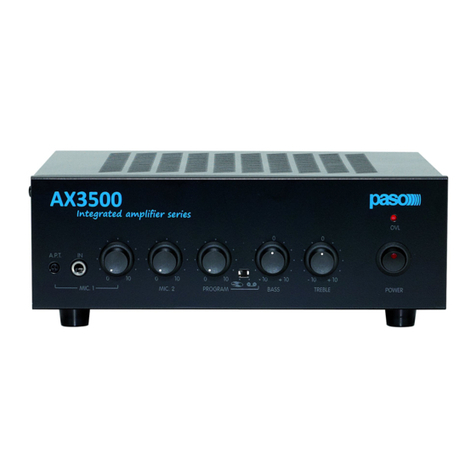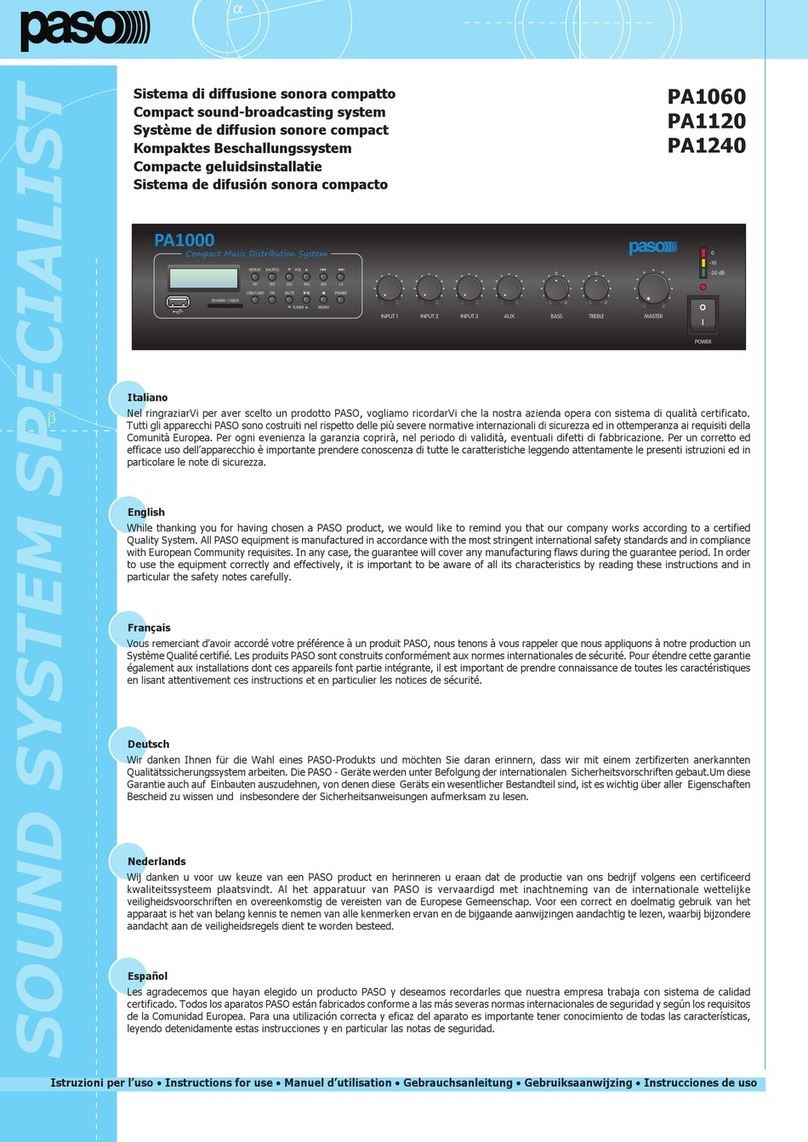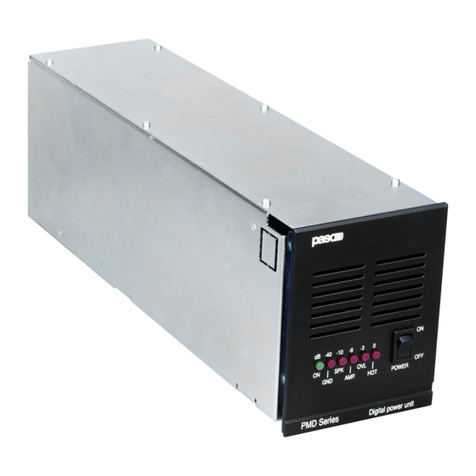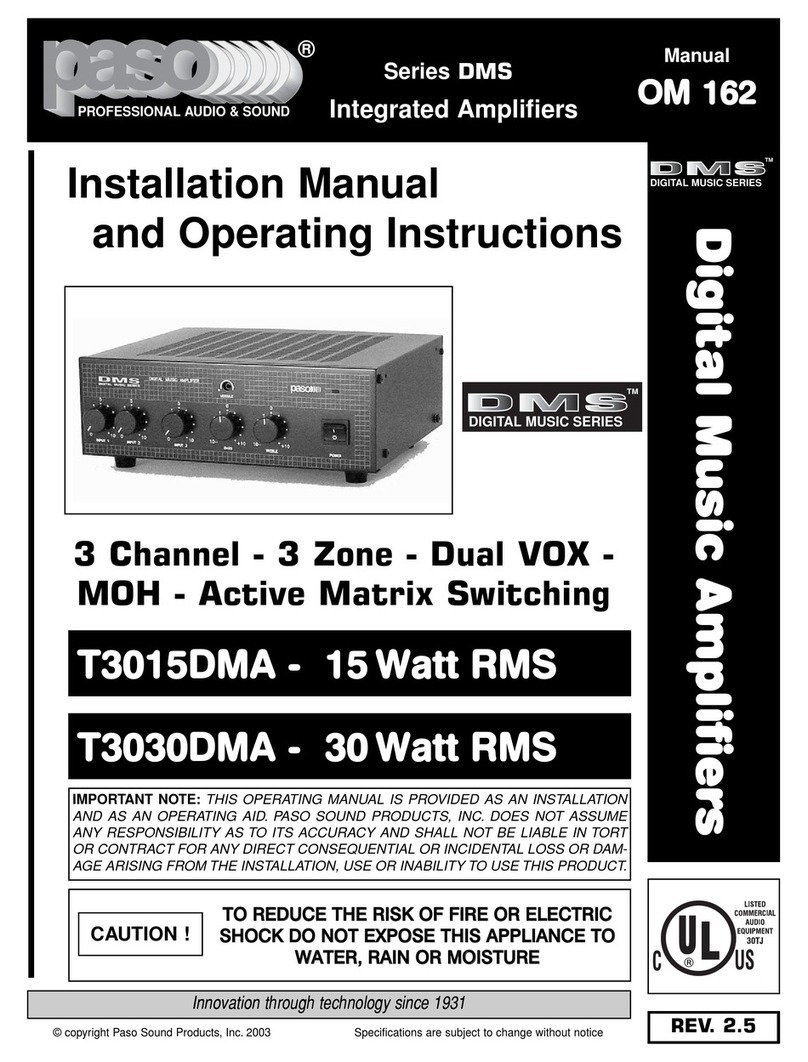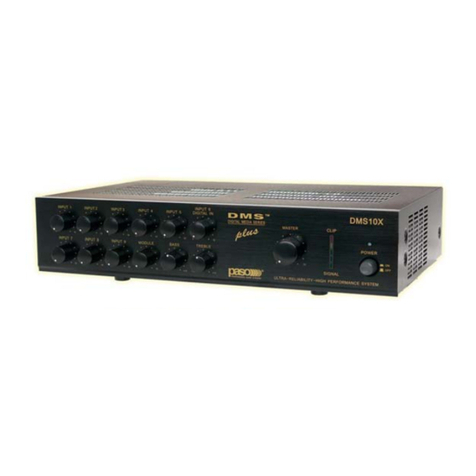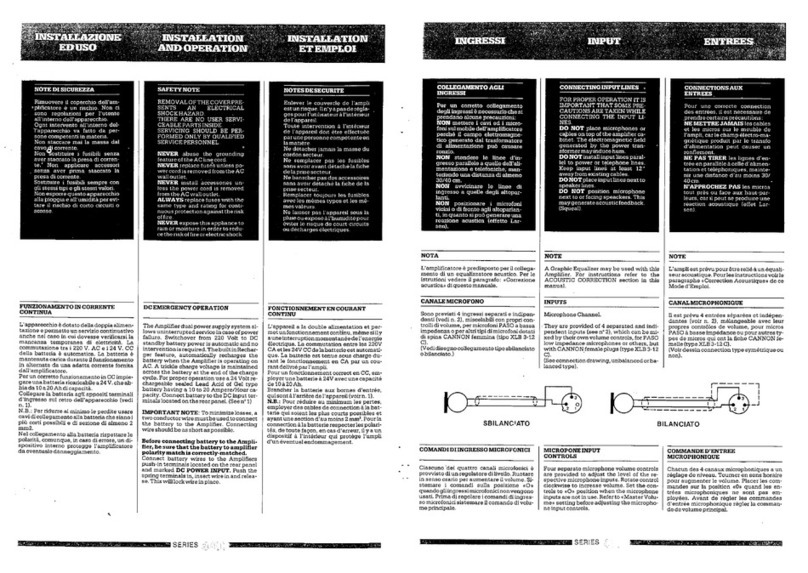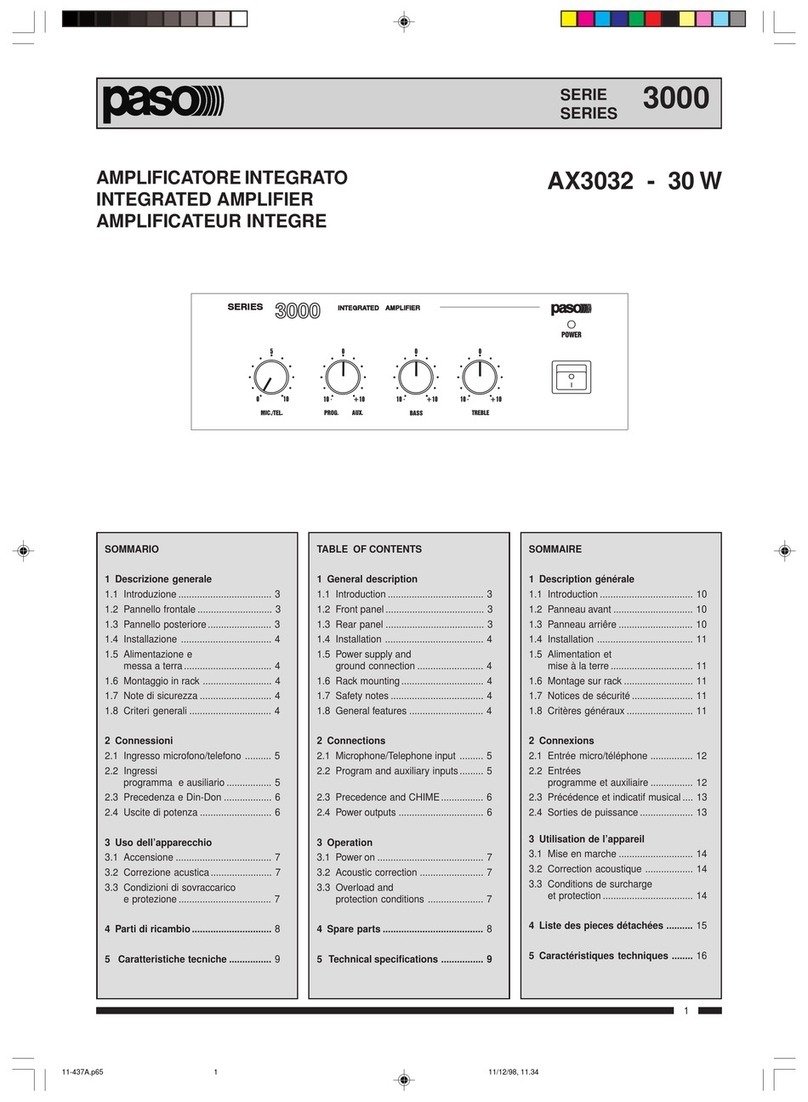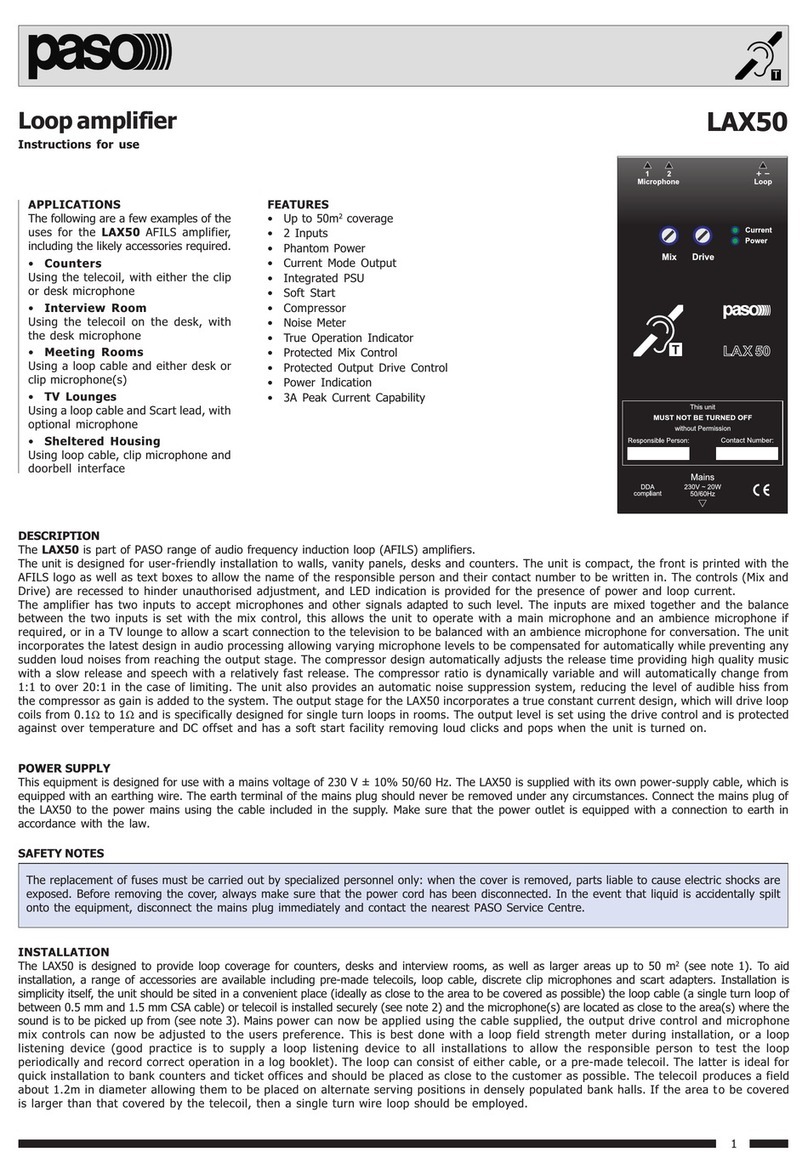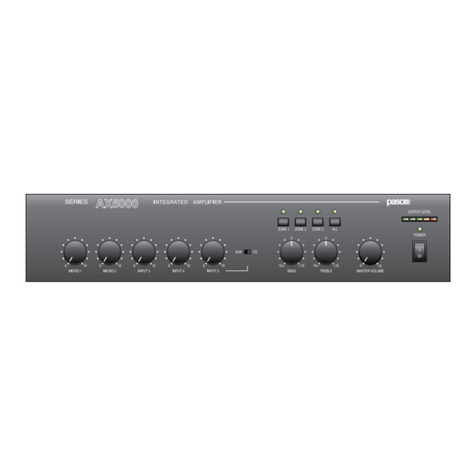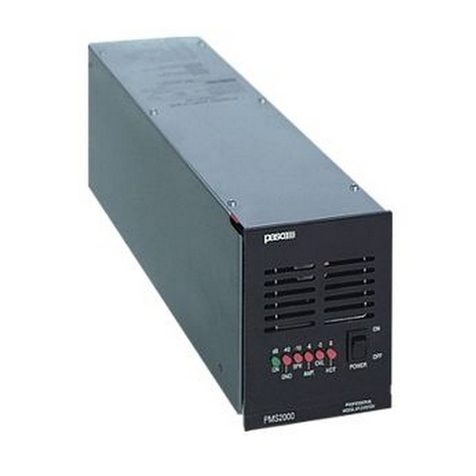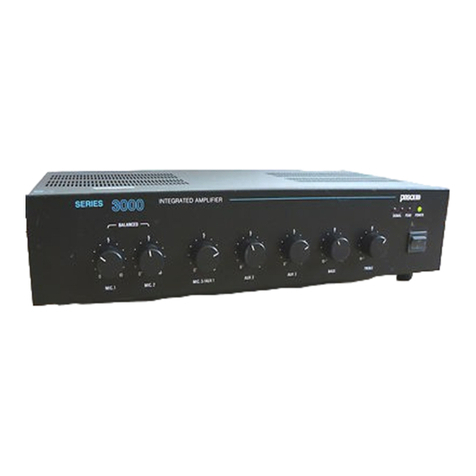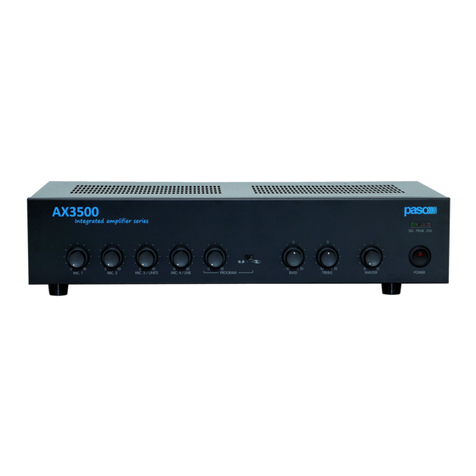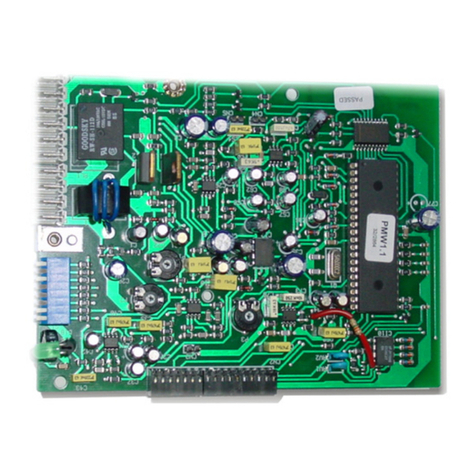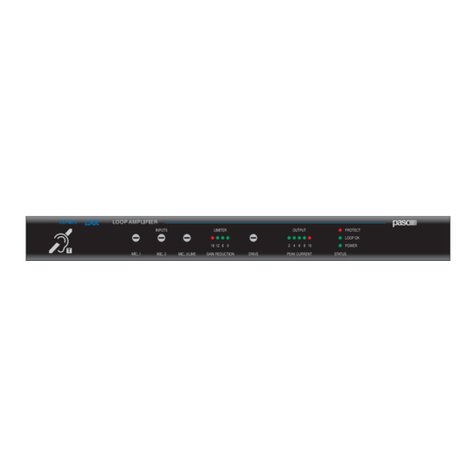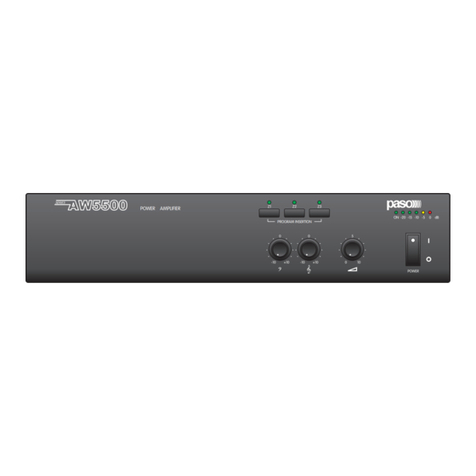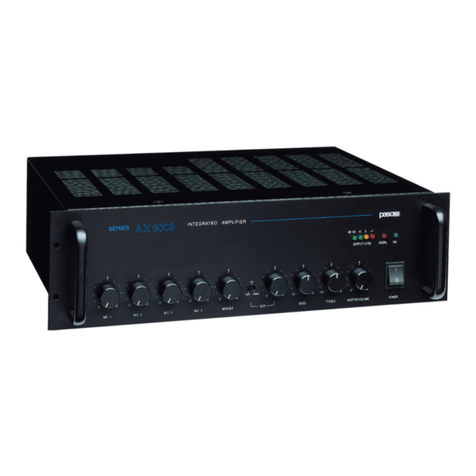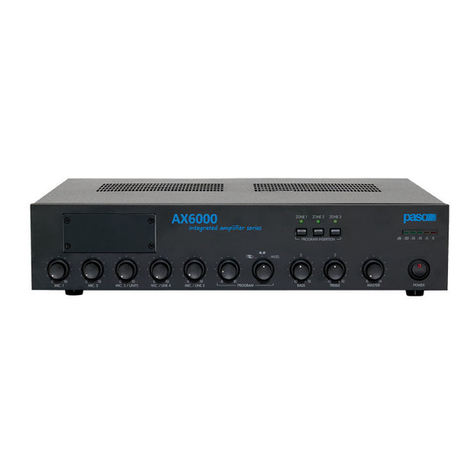
7SERIE 8000
OPERATION4USO DELL'APPARECCHIO
4.1 ACCENSIONE
Prima di mettere in funzione l’apparecchio accertarsidi avererealizzato
correttamente tutte le connessioni. Portare l’interruttore di rete [6] in
posizione
“ON”
o,in alternativa,applicareuna sorgente dialimentazione
esterna in corrente continua a 24 V. La spia luminosa “POWER” [7]
confermerà l’accensione dell’apparecchio.
4.2 SELEZIONE E CONTROLLO DEGLI INGRESSI
Selezionare, tramite il selettore rotativo [4], l’ingresso desiderato: CD,
TAPE,TUNER o LINE.
Regolare ora i controlli [1] e [3] per ottenere il desiderato livello di
equalizzazione tra le diverse sorgenti; per questa operazione si
consiglia di regolare il comando di volume principale [5] nell’intorno di
metà corsa.
Quando un ingresso non e’utilizzato, è buona norma porre
il relativo regolatore di livello sulla posizione “0”.
Per ogni ingresso microfonico è possibile attivare il filtro “SC”portando
ilrelativodeviatore[2]in posizione“
ON
”;il filtroinserisceuna particolare
curva di equalizzazione che migliora intelligibilità del parlato.
4.3 CONTROLLO DIVOLUME PRINCIPALE
Ilcontrollo di volumeprincipale MASTER [5]regola illivellocomplessivo
del segnale di uscita, derivato dalla miscelazione dei vari segnali di
ingresso.Nel caso di più P8033 (P8033/117) collegati in cascata solo
ilcontrollo MASTER dell’ultimo apparecchio della catena regola il livello
complessivo di tutti gli ingressi in miscelazione.
4.4 PRECEDENZA BASE AMPLIFICATA
Premendo il tasto di chiamata sulle basi amplificate della serie B500,
collegate al relativo ingresso del miscelatore [19],si attivala condizione
di precedenza, viene cioè opportunamente attenuato il livello
dell’ingresso ausiliario selezionato. E’ così possibile inviare un
messaggio dalla base microfonica senza sovrapposizione di segnale
musicale.
4.5 PRECEDENZA AUTOMATICA
Un circuito elettronico provvede ad ammutolire automaticamente gli
ingressi“AUX”quandoviene rilevatala presenza di segnale all’ingresso
“BASE IN”.È possibile in questo modo diffondere un messaggio vocale
semplicemente parlando al microfono, senza dover intervenire
manualmente per comandare l’attenuazione del programma musicale.
Il livello di segnale necessario all’attivazione della precedenza
automatica può essere regolato tramite il controllo A.P.T. (Automatic
Precedence Threshold) [18], accessibile dal pannello posteriore. La
regolazioneé necessaria al fine di evitarel’attivazionedellaprecedenza
automaticaper effettodi eventualirumori di fondoraccoltidal microfono.
4.6 PRECEDENZA MICROFONICA
Gli ingressi microfonici del miscelatore, dal n° 2 al n ° 6, sono dotati di
un circuito di ammutolimento attivabile per mezzo dei contatti della
morsettiera “PRECEDENCE” [11]:
• cortocircuitando il terminale “+” (uno dei due terminali comuni) con
il terminale "I" vengono ammutoliti gli ingressi microfonici 2, 3, 4, 5,
6 e l’ingresso ausiliario selezionato,
• cortocircuitando il terminale “+” con il terminale "II" vengono
ammutoliti gli ingressi microfonici 3, 4, 5, 6 e l’ingresso ausiliario
selezionato.
• cortocircuitando il terminale “+” con il terminale "III" vengono
ammutoliti gli ingressi microfonici 4, 5, 6 e l’ingresso ausiliario
selezionato.
• cortocircuitando il terminale “+” con il terminale "IV" vengono
ammutoliti soltanto gli ingressi ausiliari.
Il microfono ad impugnatura PASO M906 e la base microfonica (non
amplificata) B501 sono predisposti per il collegamento alla morsettiera
“PRECEDENCE”. Per realizzare la connessione, inserire la spina
microfonica nell’ingresso desiderato, collegare il capocorda del filo
bianco al morsetto contrassegnato dalla lettera “+” (comune) e quello
del filo verde al morsetto corrispondente al livello di priorità prescelto.
4.1 POWER UP
Before switching on the apparatus, make sure that all the connections
havebeen made correctly.Place themains switch[6]to the
“ON”
position
or, as an alternative, apply an external 24V DC source.The “POWER”
indicator lamp [7] will light up to confirm that the apparatus is switched
on.
4.2 INPUT SELECTION AND CONTROL
Usingthe rotary selector[4], select the desiredinput:TAPE, CD,TUNER
or LINE.
Now regulate the controls [1] and [3] to obtain the desired equalization
level between the various sources; to do this, we recommend that you
regulate the main volume control [5] to about the centre of its travel.
When an input is not used, its level regulator should always be set to
the “0” position.
For each microphone input, the “SC” filter can be activated by turning
the corresponding switch [2] to its “
ON
” position; the filter activates a
special equalization curve that makes the speech more intelligible.
4.3 MASTERVOLUME CONTROL
The main volume control MASTER [5] regulates the overall volume of
the output signal, obtained by mixing the various input signals.If more
than one P8033 (P8033/17) is cascaded, only the MASTER control of
the last device in the chain regulates the overall volume of all the mixed
inputs.
4.4 AMPLIFIED BASE PRECEDENCE
When the call key is pressed on the amplified bases in the B500 series,
connected to corresponding input of the mixer [19], precedence
conditionis activated,the level of the selected auxiliary input is therefore
attenuated. In this way, a message can be transmitted from the
microphone base without having to talk over the music.
4.5 AUTOMATIC PRECEDENCE
An electronic circuit automatically mutes the “AUX” inputs when the
presence of a signal is detected at the “BASE IN” input. In this way, a
voice message can be transmitted simply by talking into the
microphone, without having to turn down the music manually.
The level of the signal necessary to activate automatic precedence
may be regulated using the A.P.T. (Automatic Precedence Threshold)
control [18], accessible from the rear panel. Regulation is necessary
to avoid automatic precedence being activated by background noise
picked up by the microphone.
4.6 MICROPHONE PRECEDENCE
The microphone inputs of the mixer, from no.2 to no.6, are equipped
with a muting circuit which may be activated by means of the contacts
on the “PRECEDENCE” terminal strip [11]:
• by short-circuiting the “+” terminal (one of the two common
terminals) with terminal “I”, microphone inputs 2, 3, 4, 5 and 6 and
the selected auxiliary input can be muted.
• by short-circuiting the “+” terminal with terminal “II”, microphone
inputs 3, 4, 5 and 6 and the selected auxiliary input are muted.
• by short-circuiting the “+” terminal with terminal “III”, microphone
inputs 4, 5 and 6 and the selected auxiliary input are muted.
• by short-circuiting the “+” terminal with terminal “IV”, only the
auxiliary inputs are muted.
ThePASO M906 handheld microphone and the B501 microphone base
(non-amplified) are designed for connection to the “PRECEDENCE”
terminal strip.To make the connection, insert the microphone plug in
the desired input, connect the lug on the white wire to the terminal
marked “+” (common) and the lug on the green wire to the terminal
corresponding to the selected precedence level.
